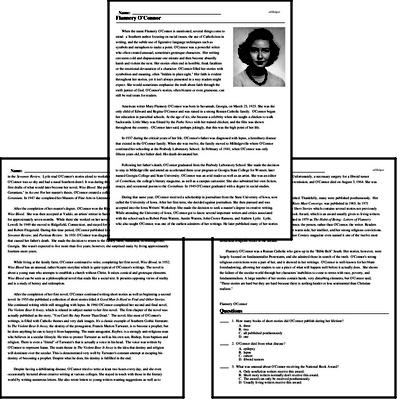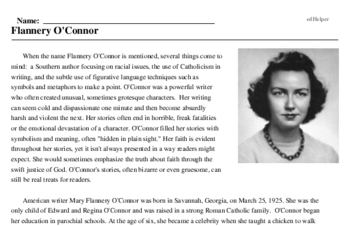Flannery O'Connor
When the name Flannery O'Connor is mentioned, several things come to mind: a Southern author focusing on racial issues, the use of Catholicism in writing, and the subtle use of figurative language techniques such as symbols and metaphors to make a point. O'Connor was a powerful writer who often created unusual, sometimes grotesque characters. Her writing can seem cold and dispassionate one minute and then become absurdly harsh and violent the next. Her stories often end in horrible, freak fatalities or the emotional devastation of a character. O'Connor filled her stories with symbolism and meaning, often "hidden in plain sight." Her faith is evident throughout her stories, yet it isn't always presented in a way readers might expect. She would sometimes emphasize the truth about faith through the swift justice of God. O'Connor's stories, often bizarre or even gruesome, can still be real treats for readers.
American writer Mary Flannery O'Connor was born in Savannah, Georgia, on March 25, 1925. She was the only child of Edward and Regina O'Connor and was raised in a strong Roman Catholic family. O'Connor began her education in parochial schools. At the age of six, she became a celebrity when she taught a chicken to walk backwards. Little Mary was filmed by the Pathe News with her trained chicken, and the film was shown throughout the country. O'Connor later said, perhaps jokingly, that this was the high point of her life.
In 1937 during the critical years of her life, O'Connor's father was diagnosed with lupus, a hereditary disease that existed in the O'Connor family. When she was twelve, the family moved to Milledgeville where O'Connor continued her schooling at the Peabody Laboratory School. In February of 1941, when O'Connor was only fifteen years old, her father died. His death devastated her.
Following her father's death, O'Connor graduated from the Peabody Laboratory School. She made the decision to stay in Milledgeville and attend an accelerated three-year program at Georgia State College for Women, later named Georgia College and State University. O'Connor was an avid reader as well as an artist. She was an editor of Corinthian, the college's literary magazine, as well as a campus cartoonist. She also submitted her own fiction, essays, and occasional poems to the Corinthian. In 1945 O'Connor graduated with a degree in social studies.




